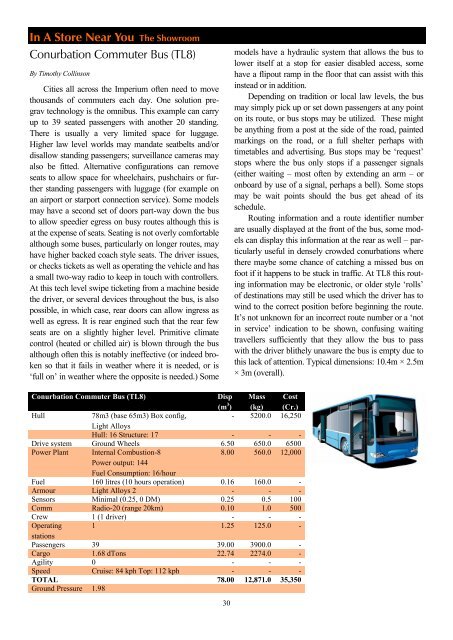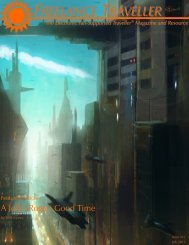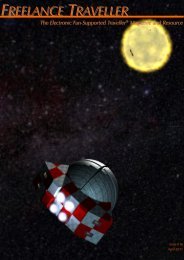ISO A4 format - Freelance Traveller
ISO A4 format - Freelance Traveller
ISO A4 format - Freelance Traveller
Create successful ePaper yourself
Turn your PDF publications into a flip-book with our unique Google optimized e-Paper software.
In A Store Near You The Showroom<br />
Conurbation Commuter Bus (TL8)<br />
By Timothy Collinson<br />
Cities all across the Imperium often need to move<br />
thousands of commuters each day. One solution pregrav<br />
technology is the omnibus. This example can carry<br />
up to 39 seated passengers with another 20 standing.<br />
There is usually a very limited space for luggage.<br />
Higher law level worlds may mandate seatbelts and/or<br />
disallow standing passengers; surveillance cameras may<br />
also be fitted. Alternative configurations can remove<br />
seats to allow space for wheelchairs, pushchairs or further<br />
standing passengers with luggage (for example on<br />
an airport or starport connection service). Some models<br />
may have a second set of doors part-way down the bus<br />
to allow speedier egress on busy routes although this is<br />
at the expense of seats. Seating is not overly comfortable<br />
although some buses, particularly on longer routes, may<br />
have higher backed coach style seats. The driver issues,<br />
or checks tickets as well as operating the vehicle and has<br />
a small two-way radio to keep in touch with controllers.<br />
At this tech level swipe ticketing from a machine beside<br />
the driver, or several devices throughout the bus, is also<br />
possible, in which case, rear doors can allow ingress as<br />
well as egress. It is rear engined such that the rear few<br />
seats are on a slightly higher level. Primitive climate<br />
control (heated or chilled air) is blown through the bus<br />
although often this is notably ineffective (or indeed broken<br />
so that it fails in weather where it is needed, or is<br />
‘full on’ in weather where the opposite is needed.) Some<br />
models have a hydraulic system that allows the bus to<br />
lower itself at a stop for easier disabled access, some<br />
have a flipout ramp in the floor that can assist with this<br />
instead or in addition.<br />
Depending on tradition or local law levels, the bus<br />
may simply pick up or set down passengers at any point<br />
on its route, or bus stops may be utilized. These might<br />
be anything from a post at the side of the road, painted<br />
markings on the road, or a full shelter perhaps with<br />
timetables and advertising. Bus stops may be ‘request’<br />
stops where the bus only stops if a passenger signals<br />
(either waiting – most often by extending an arm – or<br />
onboard by use of a signal, perhaps a bell). Some stops<br />
may be wait points should the bus get ahead of its<br />
schedule.<br />
Routing in<strong>format</strong>ion and a route identifier number<br />
are usually displayed at the front of the bus, some models<br />
can display this in<strong>format</strong>ion at the rear as well – particularly<br />
useful in densely crowded conurbations where<br />
there maybe some chance of catching a missed bus on<br />
foot if it happens to be stuck in traffic. At TL8 this routing<br />
in<strong>format</strong>ion may be electronic, or older style ‘rolls’<br />
of destinations may still be used which the driver has to<br />
wind to the correct position before beginning the route.<br />
It’s not unknown for an incorrect route number or a ‘not<br />
in service’ indication to be shown, confusing waiting<br />
travellers sufficiently that they allow the bus to pass<br />
with the driver blithely unaware the bus is empty due to<br />
this lack of attention. Typical dimensions: 10.4m × 2.5m<br />
× 3m (overall).<br />
Conurbation Commuter Bus (TL8)<br />
Disp<br />
(m 3 )<br />
Mass<br />
(kg)<br />
Cost<br />
(Cr.)<br />
Hull<br />
78m3 (base 65m3) Box config,<br />
- 5200.0 16,250<br />
Light Alloys<br />
Hull: 16 Structure: 17 - - -<br />
Drive system Ground Wheels 6.50 650.0 6500<br />
Power Plant Internal Combustion-8<br />
8.00 560.0 12,000<br />
Power output: 144<br />
Fuel Consumption: 16/hour<br />
Fuel 160 litres (10 hours operation) 0.16 160.0 -<br />
Armour Light Alloys 2 - - -<br />
Sensors Minimal (0.25, 0 DM) 0.25 0.5 100<br />
Comm Radio-20 (range 20km) 0.10 1.0 500<br />
Crew 1 (1 driver) - - -<br />
Operating 1 1.25 125.0 -<br />
stations<br />
Passengers 39 39.00 3900.0 -<br />
Cargo 1.68 dTons 22.74 2274.0 -<br />
Agility 0 - - -<br />
Speed Cruise: 84 kph Top: 112 kph - - -<br />
TOTAL 78.00 12,871.0 35,350<br />
Ground Pressure 1.98<br />
30

















